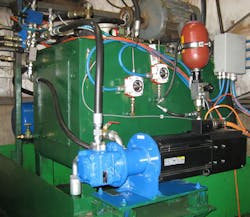Most of us call them Popsicle sticks. More correctly, they’re called ice-pop sticks. But whatever you call them, John Lewis Industries Ltd., La Tuque, Canada, has been making ice-cream sticks (as they call them) since 1920 and now produces more than 26 million of them a day. Not surprisingly, the company also produces tongue depressors for the medical industry and coffee stirrers and wooden sticks for hobbies and crafts. Roughly 85% of Lewis’s output is exported to countries around the world.
Always looking for ways to conserve energy, company officials launched an optimization project for the production process. Following initial studies, they consulted with energy-efficiency specialists from Bosch Rexroth to take a close look at the power unit for the hydraulically driven axes in the plant’s wood-receiving station.
It ain’t broke, but fix it
Incoming timber arrives at the plant as 8 to 10-ft logs that are routed to a receiving station, where an automatic lift device raises the logs and moves them into a peeling mill. The peeling mill strips thin sections of wood from the log, and the peeled wood undergoes further processing. If any obstruction occurs in the receiving station, an operator uses a hydraulic crane to free the jam. Hydraulics for the crane are fed by the same hydraulic power unit (HPU) that serves the receiving station. This HPU was the focus of the project.
Because this is such a high-production operation, interruptions are not an option. Rodney Trail, of Bosch Rexroth Canada, explained that to ensure the operator could always respond quickly to carry out the unjamming procedure — which is initiated manually — designers originally specified a fixed-displacement pump running at full speed. This ensured that maximum hydraulic flow was available to give the hydraulic quick response. When full power wasn’t needed, excess flow was routed to tank. At full load, the HPU required 20 kW of power and 12 kW even at partial load.
Specialists at Rexroth determined that using a fixed-displacement pump driven by a variable-speed electric motor could save substantial energy without affecting system speed, power, or response. Trail said his team recommended using Bosch Rexroth’s Sytronix SvP7000 variable-speed pump drive. Bosch Rexroth’s IndraDrive intelligent control reduces the pump’s rotational speed during idling phases or when operating at partial load to deliver just the amount of flow actually called for by the crane operator.
The IndraDrive runs the hydraulic pump at speeds from 0 to 2,700 rpm, which generate flows to 60 lpm. The motor-pump drive also closed-loop pressure control up to 100 bar and maintains it within about 0.3 bar.
This conversion brought about instant success. When running at partial load, the hydraulic power unit now uses just 2 kW — a 70% energy saving. Trail explained that the conversion itself was fairly easy and uncomplicated. “Predefined functions and open interfaces for command-level communications simplify integration, even into preexisting systems. Users need not carry out any extensive programming. They need only assign parameters to the predefined regulators.”
It’s quieter, too
Energy is one factor but an acceptable working environment for the employees is just as important. “We are not talking just about energy savings, but also about considerable noise reduction and better system response,” explained Stéphane Pronovost, project manager at John Lewis Industries and responsible for rebuilding the system. That’s because the Sytronix reduces, on the one hand, average noise emissions by up to 20 dB — and without any additional noise abatement measures. The rapid response to changes in flow and pressure requirements give the crane more-precise movement and makes it easier to operate.
Set for the future
In addition, Sytronix reduces the amount of cooling required since the hydraulic fluid heats up less than in the past. This both extends the service life of the hydraulic fluid and further reduces energy requirements. “I hope that this technology will become the industry standard for all hydraulic power units in the future,” Pronovost stressed. John Lewis Industries is making its contribution and is even now examining the feasibility of converting another power plant.
For more information on Bosch Rexroth’s Sytronix hydraulic motor-pump drives, visit bit.ly/190RzKt.



